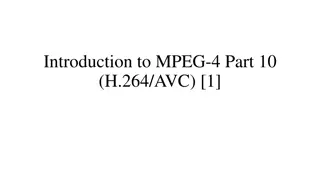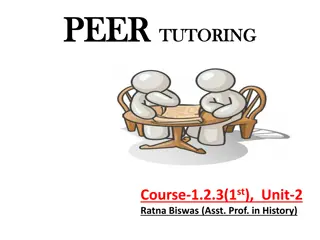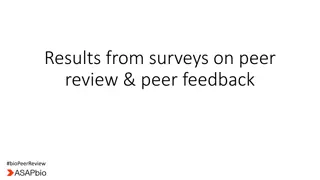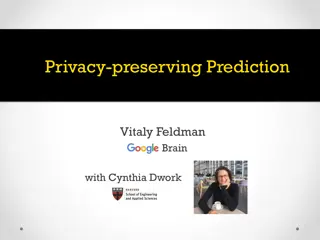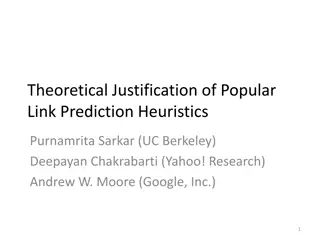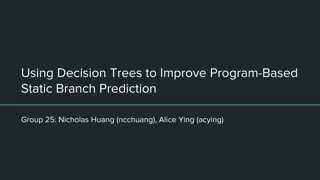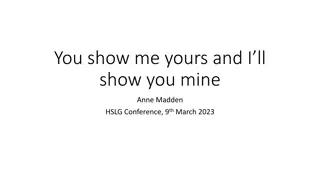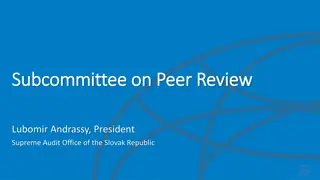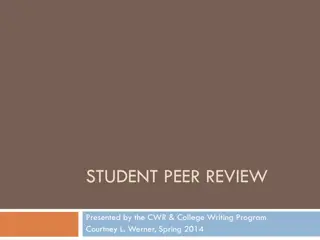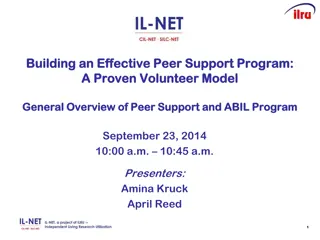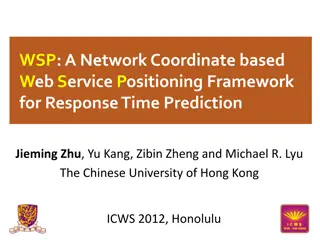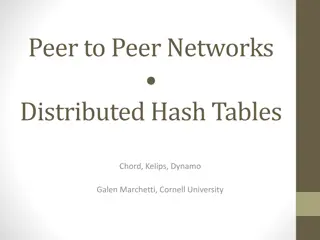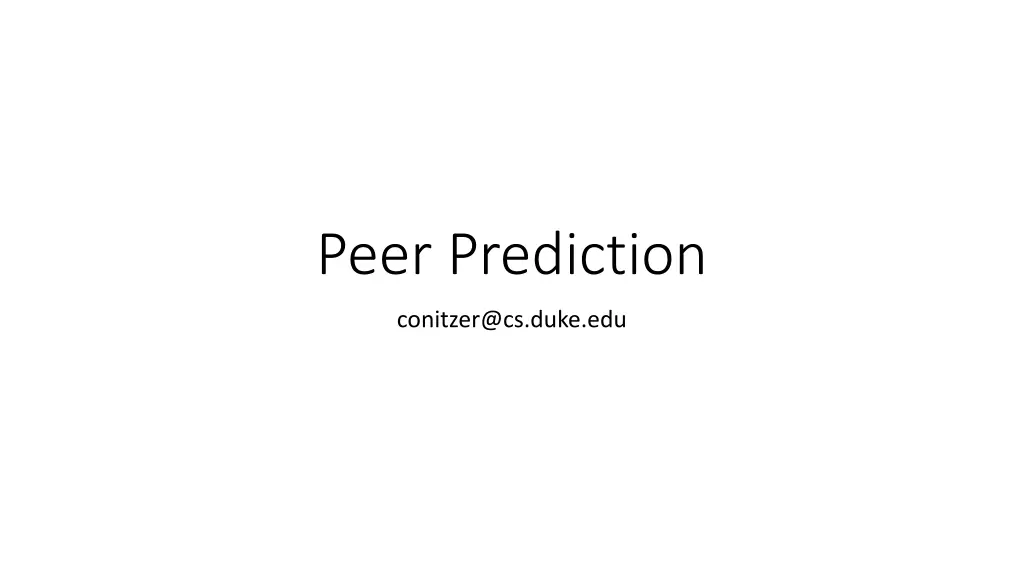
Understanding Peer Prediction Mechanisms
Explore the concept of peer prediction through evaluating experiences in a theme park scenario and examining the effectiveness of the 1/Prior mechanism. Discover how multiple raters and output agreement can influence accuracy in reporting, with practical examples illustrating potential pitfalls and successes in the process.
Download Presentation

Please find below an Image/Link to download the presentation.
The content on the website is provided AS IS for your information and personal use only. It may not be sold, licensed, or shared on other websites without obtaining consent from the author. If you encounter any issues during the download, it is possible that the publisher has removed the file from their server.
You are allowed to download the files provided on this website for personal or commercial use, subject to the condition that they are used lawfully. All files are the property of their respective owners.
The content on the website is provided AS IS for your information and personal use only. It may not be sold, licensed, or shared on other websites without obtaining consent from the author.
E N D
Presentation Transcript
Peer Prediction conitzer@cs.duke.edu
Example setup We are evaluating a theme park which can be either Good or Bad P(G) = .8 If you visit, you can have an Enjoyable or an Unpleasant experience P(E|G) = .9, P(E|B) = .7 We ask people to report their experiences and want to reward them for accurate reporting I had fun. E quality: good The problem: we will never find out the true quality / experience. Another nice application: peer grading (of, say, essays) in a MOOC.
I had fun. E Solution: use multiple raters quality: good I had fun. E Rough idea: other agent likely (though not surely) had a similar experience Evaluate a rater by how well her report matches the other agent s report How might this basic idea fail?
Simple approach: output agreement Receive 1 if you agree, 0 otherwise What s the problem? What is P(other reports E | I experienced U) (given that the other reports truthfully)? P(E |U) = P(U and E ) / P(U) P(U and E ) = P(U, E , G) + P(U, E , B) = .8 .1 .9 + .2 .3 .7 = .072+.042 = .114 P(U) = P(U,G) + P(U,B) = .8 .1 + .2 .3 = .08 + .06 = .14 So P(E |U) = .114 / .14 = .814 P(E |E) = P(E and E ) / P(E) P(E and E ) = P(E, E , G) + P(E, E , B) = .8 .9 .9 + .2 .7 .7 = .648 + .098 = .746 P(E) = P(E,G) + P(E,B) = .8 .9 + .2 .7 = .72 + .14 = .86 So P(E |E) = .746 / .86 = .867
The 1/Prior mechanism [Jurca&Faltings08] Receive 1/P(s) if you agree on signal s, 0 otherwise P(E) = .86 and P(U) = .14 so 1/P(E)=1.163 and 1/P(U)=7.143 P(E |U) (1/P(E )) = .814*1.163 =.95 but, P(U |U)(1/P(U )) = .186*7.143=1.33 Why does this work? (When does this work?) Need, for all signals s, t: P(s |s)/P(s ) > P(t |s)/P(t ) Equivalently, for all signals s, t: P(s,s )/P(s ) > P(s,t )/P(t ) Equivalently, for all signals s, t: P(s|s ) > P(s|t )
An example where the 1/Prior mechanism does not work P(A|Good)=.9, P(B|Good)=.1, P(C|Good)=0 P(A|Bad)=.4, P(B|Bad)=.5, P(C|Bad)=.1 P(Good)=P(Bad)=.5 Note that P(B|B ) < P(B|C ), so the condition from the previous slide is violated Suppose I saw B and the other player reports honestly P(B |B) = P(B , Good|B) + P(B , Bad|B) = P(B |Good)P(Good|B) + P(B |Bad)P(Bad|B) = .1*(1/6) + .5*(5/6) = 13/30 P(B ) = 3/10, so expected reward for reporting B is 130/90 = 13/9 = 1.44 P(C |B) = P(C , Good|B) + P(C , Bad|B) = P(C |Good)P(Good|B) + P(C |Bad)P(Bad|B) = 0*(1/6) + .1*(5/6) = 1/12 P(C ) = 1/20, so expected reward for reporting C is 20/12 = 5/3 = 1.67
Better idea: use proper scoring rules Assuming the other reports truthfully, can infer a conditional distribution over the other s report given my report Reward me according to a proper scoring rule! Suppose we use the logarithmic rule Reporting E predicting the other reports E with P(E |E) = .867 Reporting U predicting the other reports E with P(E |U) = .814 E.g., if report E and the other reports U , I get ln(P(U |E)) = ln .133 In what sense does this work? Truthful reporting is an equilibrium
as a Bayesian game A player s type (private information): experience the player truly had (E or U) Note types are correlated (only displaying player 1 s payoffs) E U E U true true experiences: E and U (prob. .114) experiences: E and E (prob. .746) E E ln .867 ln .133 ln .867 ln .133 ln .814 ln .186 ln .814 ln .186 U U E U E U true true experiences: U and U (prob. .026) experiences: U and E (prob. .114) E E ln .867 ln .133 ln .867 ln .133 ln .814 ln .186 ln .814 ln .186 U U
E U E U true true experiences: E and U (prob. .114) experiences: E and E (prob. .746) E E -.143 -2.017 -.143 -2.017 -.205 -1.682 -.205 -1.682 U U E U E U true true experiences: U and U (prob. .026) observe E: report U observe U: report U experiences: U and E (prob. .114) E E -.143 -2.017 -.143 -2.017 -.205 -1.682 -.205 -1.682 U U observe E: report U observe U: report E observe E: report E observe U: report E observe E: report E observe U: report U -.404, -.404 -.152, -.405 -1.970, -.412 -1.718, -.413 observe E: report E observe U: report U observe E: report E observe U: report E -.405, -.152 -.143, -.143 -2.017, -.205 -1.755, -.196 -.412, -1.970 -.205, -2.017 -1.682, -1.682 -1.475, -1.729 observe E: report U observe U: report U observe E: report U observe U: report E -.413, -1.718 -.196, -1.755 -1.729, -1.475 -1.512, -1.512
Downsides (and how to fix them, maybe?) Multiplicity of equilibria Completely uninformative equilibria Uselessly informative equilibria: Users may be supposed to evaluate whether the image contains a person, but instead reach an equilibrium where they evaluate whether the top-left pixel is blue Need to know the prior distribution beforehand Explicitly report beliefs as well [Prelec 04] Bonus-penalty mechanism [Dasgupta&Ghosh 13, Shnayder et al. 16]: Suppose there are 3 tasks (e.g., 3 essays to grade) You get a bonus for agreeing on the third task Agents don t know how the tasks are ordered You get a penalty for agent 1 s report on 1 agreeing with agent 2 s report on 2 Use a limited number of trusted reports (e.g., the instructor grades) ?


